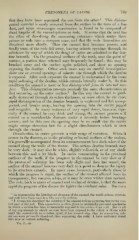Page 759 - My FlipBook
P. 759
PHENOMENA OF CARIES. 769
that they have been separated the one from the other.' This disinte-
grated material is easily removed from the surface in the form of a fine
dust, and upon microscopic examination is found to be composed of
short lengths of the enamel-prisms or rods. It seems that the acid has
the eifect of dissolving; the connecting substance which unites these
prisms or rods into a compact mass, and that the rods themselves are
dissolved more slowly. Thus the enamel first becomes porous, and
finally some of the rods fall away, leaving minute openings through its
substance by way of which the fungi of caries are admitted to the den-
tine beneath. On the proximal surfiices of the teeth, near the point of
contact, a portion thus softened may frequently be found ; this may be
brushed away and the surface again polished, and show no opening
exposing the dentine. Other such cases may on careful investigation
show one or several openings of minute size through which the dentine
is exposed. After such exposure the enamel is undermined by the more
rapid softening of the dentine, which extends laterally under it. In this
condition the enamel is more or less dmntegrated from its internal siir-
face. This disintegration presents precisely the same characteristics as
that occurring on the outer surface.^ In this way the enamel is grad-
ually destroyed through its entire thickness, or more often, by the more
rapid disintegration of the dentine beneath, is weakened and left unsup-
ported, and breaks away, leaving the opening into the cavity jagged
-and irregular. In many instances of very rapid decay, however, espe-
cially if the enamel be very thick and strong, the carious process will
extend to a considerable distance under it laterally before breakage
occurs ; and in this case the opening may be so small that the cavity
might escape detection but for a slight discoloration which is seen
through the enamel.
Discoloration in caries presents a wide i^ange of variation. When it
occurs in the fissures, as in the grinding or buccal surfaces of the molars,
it is generally accompanied from its commencement by a dark color of the
enamel along the walls of the fissure. The carious dentine beneath may
be very dark ; it may also be white, slightly yellowish, or of any shade
between this and a jet black. In caries commencing in the proximal
surfaces of the teeth, if the progress in tlie enamel be very slow or if
the process of softening has been only slight and then has ceased, the
surface of the enamel becomes very dark to a point as deep as the injury
to its structure extends. In many cases, however, particularly those in
which the progress is rapid, the surface of the enamel afi'ected loses its
transparency, but remains white, or it may be even whiter than normal.
The rule, both in caries of enamel and in that of dentine, is that the more
rapid the progress of the disease the lighter the resultant color. But even
' As representing the histological elements of the enamel, the words prisms, crystals,
and rods have been used in a like sense by writers.
' J. Tomes has described the solntion of the enamel-rods as occnrring first in the cen-
tral part of the rod. This appearance is often given in artificially-prepared specimens
in which a section has been momentarily exposed to the action of an acid. But in all
of my experiments in which sections have been exposed to the action of dilute acids
until the enamel-rods have fallen apart, it has seemed clear that the connecting sub-
stances were primarily dissolved, thus separating the rods. I have uniformly found
this true of carious softening.
Vol. I.—49


